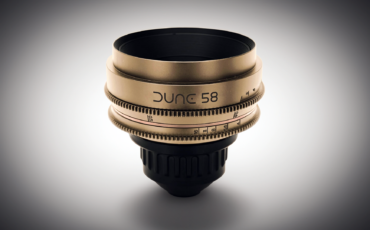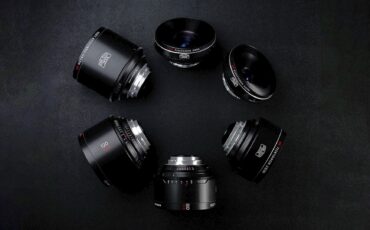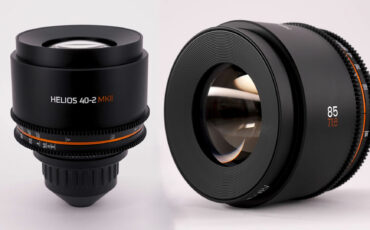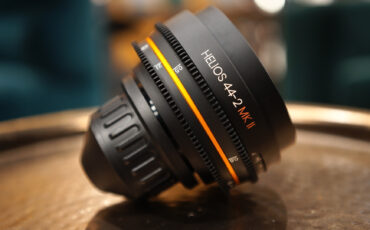IronGlass MK II Review – Vintage Optics Reborn?
Restriction-free music courtesy of Epidemic Sound. Sign up here: Epidemic
To say that the optics rehousing company, IronGlass, based out of Ukraine, has had a wild ride over the past few years would be an understatement. The company found early success with their MKI rehousing project based on taking old Soviet optics and rehousing them for cinema uses. Now, their MKII housings are shipping, and IronGlass is branching into another legendary line of vintage optics: Carl Zeiss Jena. A large portion of this work has taken place under the specter of the invasion of Ukraine by Russia. Hop below for more of my thoughts on the MKII line from IronGlass.
This will be a unique review for me because it will mostly discuss the purchasing process from IronGlass and the design of the IronGlass MKII housing specifically. We won’t delve too much into the look of the internal optics because this range of glass might be one of the most written about in history. The Helios line of optics, in particular, has been produced for decades. Fundamentally, the look hasn’t changed, but nearly everything else about these lenses has, thanks to IronGlass.
A core question remains: if these lenses in their original form can be purchased relatively inexpensively, how can a company justify charging thousands of dollars for the same lens? Stay tuned for my answer.
But first, a bit of history.
Helios lenses first found popularity in the late 50s. They were initially used on M42 lens mount cameras and eventually built for the Pentax K mount. Around 1969, the Helios 44-2 entered production, and to this day, it is one of the most widely produced lenses ever, making it extremely easy and affordable to acquire. Some were even manufactured in Japan over the years. Famous for its swirly bokeh, the Helios 44-2, now in MKII form, is enjoying yet another resurgence along with a few other IronGlass rehoused primes with its apparent use on Dune 2 (in the capable hands of DP Greg Fraser).
The Art & Science of Lenses
Cine-Modding versus rehousing
I wanted to quickly touch on the differences between a Cine-Mod and a complete rehousing because I see lots of confusion about this online and it might help to clarify things. Cine-Modding a lens can mean adding a simple 0.8 pitch gear to the outside of a focus ring or de-clicking an aperture ring (Duclos famously does quality Cine-Mod work, and so does IronGlass).
IronGlass goes a bit further than some with their Cine-Mod program by adding internal color and even bokeh modifications in their cine-modded optics, available in PL, E, X, EF, and M4/3 mount.
Rehousing may mean adapting a photo lens to cine applications by unifying the body design so your follow-focus can stay in place on the rods, then de-clicking the iris, expanding distance markings, and making the focus mechanics work in a cine housing. Rehousing results may vary when you look at the entire market, and some companies simply add a shell around a vintage lens and call it good. A bad rehousing job means tons of servicing requirements. A good rehousing job means these lenses, handled with care, could follow you around for most of your career.
For me, a Cine-Modded lens is one that I’d use mostly in a studio environment, but I wouldn’t rent it out or use it on a long-term job in rugged circumstances. It also isn’t something that plays well with various wireless follow-focus options on the market. You can occasionally even damage a Cine-Modded lens with the torque from a wireless follow-focus motor if you aren’t careful – likely not the case with a rehoused Cine lens.
IronGlass isn’t the only company working on rehousing projects for cine glass, but they are on the more affordable side when you compare them with other companies – even with the increase in pricing that came with the MKII designs.
Purchasing an MKII Set from IronGlass
Early on, I was interested in the Helios 44-2, but I found the varying build quality of these lenses and the quality control discouraging. A quick search of Helios 44-2 reveals a wide variety of choices ranging in price from $50-$150 for the more “mint” offerings. Having recently gone down the path of searching for a Leica R 19mm V2, I noticed that the definition of “mint” is all over the map. Some vintage optics hunters may enjoy the process of searching for nice copies, but I’d prefer someone else do the hunting, and I’m happy to pay a bit more for that.
My first order of a few MKI primes in EF mount occurred on June 30, 2021. Later on, in 2021, I added a Mir-20M to my overall order. Eventually, I learned of the MKII design effort and switched my order to MKII and PL mount at the end of 2022. Finally, my 4-lens order of 20mm, 37mm, 58mm, and 135mm arrived in late February 2024. I’m breaking down the timing here so you can also be realistic about the timeline for the arrival of these optics. Still, I want to be clear that I’m not complaining, nor do I view this extended timeframe for delivery as a negative.
For one, between my order and delivery, a large land war began in the country that IronGlass calls home: Ukraine. In these extraordinary times, the fact that IronGlass delivered this order at all is incredible, and they are now well into delivering orders worldwide.
As of May 2024, IronGlass is advertising a 16-18 month lead time on all incoming rehousing orders. One of the things that initially concerned me about my purchase is the website, which is a bit tricky to navigate sometimes, with occasionally conflicting information about lead times – something I’ve now chalked up to the fact that the entire team is occupied rehousing lenses!
Pricing
When I first submitted my order and paid through PayPal back in 2021, I was initially a bit concerned about the safety and security of my purchase because I had never worked with IronGlass before. Over time, my concerns lessened as I got to know the IronGlass team and their various fans around the world. They are a small company currently working in a conflict zone, but they do incredible work (more on that later).
One of the things that did make me feel good about my IronGlass order was the reliable response to my questions via email and chat.
With the formidable design of the MKII housing (available in EF, PL, and LPL), we also saw a corresponding jump in pricing, with each lens in the set landing at $3500 (Soviet Rehoused options if you aren’t providing donor optics). Those interested in the Carl Zeiss Jena rehoused primes should expect to pay $4000 to $4500/each with a price bump to $5000 for the 80mm T1.9 – again if you aren’t providing donor optics.
You can also trade in your MKI rehoused optics towards a significant price reduction for the MKII housings. This feels like a nice way to thank early adopters of their lenses and also means you’ll lower the per-lens price of your MKII optics to around $1900 depending on your selections at checkout.
I will leave it to you to decide if finding donor optics and shipping them to Ukraine makes sense to you, all the while acknowledging that some may find that experience an enjoyable part of the process.
For an increase of +$300/each lens, you can get these lenses in white. They admittedly look very cool based on the product imagery, but I’m not sure how well that exterior would hold up in a rental or heavy-use environment against the occasional light scuff.
The design of the IronGlass MKII
For those of you who skipped the entirety of this article and zoomed right to this section, I don’t blame you. This is the main event. Just how good are the MKII’s for use on your next project?
I didn’t have the opportunity to use the MKI versions of IronGlass rehousing, but removing the new 4-lens MKII Imperial set from its box was a pleasant surprise. The first thing that caught my eye was the etched lens markings on the hood itself. Honestly, I would buy caps from this company for other lenses in my set if they offered that down the line. They’re that spiffy.
From a visual perspective, everything from the distinct orange ring to the PL back caps (complete with the IronGlass logo) is well executed and looks good. I also took a close look at the internal glass elements from each prime, and from what I could see, the engineer both picked excellent quality donor optics and cleaned those internal elements, too.
Each lens in my 4-lens MKII set has a unified 95mm front diameter that is actually the same as my SIGMA Cine Primes, so I had several clip-on matte boxes that were already compatible. They also each have a 92mm filter thread if you have a preference for that type of filter. However, the 20mm MIR-20 does not have a filter thread (likely due to the bulbous front element, I’m guessing).
Internally, IronGlass has used a hybrid focus system that “feels like a CAM-driven focus ring,” and I can confirm that the focus mechanics all feel smooth and consistent from lens to lens. The focus rings with 300 degrees of throw have a little less tension than what I prefer, but everyone is going to have a different preference there – you definitely won’t need a high-torque motor.
The close focus has also been improved over the original stills glass in some cases, and you can see those stats on each of my four MKII lenses here:
- 20mm MIR-20 • T3.6 • CF 7»
- 37mm MIR-1V • T2.9 • CF 1’10»
- 58mm HELIOS 44-2 • T2.1 • CF 1’8»
- 135mm TAIR-11A • T2.9 • CF 3’11»
Now, I promised at the top that I wouldn’t dive too far into the look from these optics. Still, I will say that generally, they match in the sense that they are vintage glass (with some characteristic and flattering softness that goes along with that). The color is fairly consistent, though you should keep in mind that they don’t 100% “match” because they were not all created in the same original factory in the 60s using the same coatings by the same lead engineer. They are all a bit different, and I’m cool with that, though if you are filming a project with VFX, you will 100% want to film a lens grid before principle photography starts.
The optics all flare differently, and their bokeh is a little different. There might be a hint of chromatic aberration here and there at different stops and different lighting scenarios, but that’s part of what makes them fun as heck to shoot with – they have character in spades. I really encourage you to take time with each of these lenses because they are truly unique, and I’m slowly forming a preference toward different looks at different T-stops. This, of course, is all part of the fun.
What IronGlass has done, though, is they have made finding out that particular character of each lens much easier by removing the variable of a wonky iris ring or a sticky focus wheel, or a broken filter thread typical of off-the-shelf vintage glass. Their work on the MKII housings has eliminated that possible headache, so you can focus on the fun parts of cinematography and not have to worry about a $50 eBay-purchased Helios falling apart in your hands mid-shoot while a client or director looks on.
Conclusion

If I have one regret from my IronGlass experience, it’s that I didn’t purchase the Helios 40-2 85mm T1.6 when I started this journey. I’m going to have to bite the bullet and begin that lengthy waiting process all over again. But here’s the thing. I know it will be worth it.
Oh, and before I close, I have to share my favorite design aspect of the MKII rehoused lenses — a small Ukrainian flag right next to the serial number.
Have you used the first generation of IronGlass rehoused optics? Will you be adding the MKII’s to your kit? Let us know in the comments below!




































